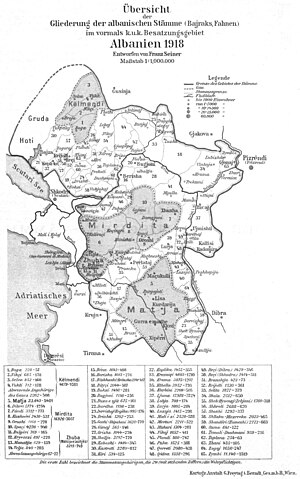Dushmani (tribe)
| Part of a series on |
| Albanian tribes |
|---|
 |
| Dushmani | |
|---|---|
 Albanians bayraks as of 1918, Dushmani covers section 61. | |
| Current region | North Albania |
The clan of Dushmani was one of the northern Albanian tribes, living in North Albania up to 20th century.[1] Edith Durham the person who visited them in the beginning of 20th century described them as one of the most wilder tribes among Albanians.[2]
Ethnography
According to Durham, Dushmani consisted in two groups, Dushmani and Temali. They were part of the district of Postripa which consisted of Mazreku, Drishti, Shlaku, and Dushmani. Ecclesiastically the tribe was wholly Christian they were included in the diocese of Pulati. Their name derived from Pal Dushmani, a 15th century Albanian lord and member of the Dushmani family. In the beginning of 20th century the group of Dushmani consisted in 160 houses.
Traditions and customs
The social life of Dushmani was organized following strictly the Code of Lekë Dukagjini. According to Durham "Dushmani believes in Lek Dukaghin as the One-that-must-be-obeyed, and that he ordered blood-vengeance. The teaching of Christ, the laws of the Church, fall on deaf ears when the law of Lek runs counter to them..". The blood vengeance was widespread among Dushmani. At the time of Edith Durham's visit, around forty houses were in blood within the tribe only, while for external bloods, they were countless.
The men of the tribe had the custom of tattooing a tiny cross upon the breast or upper arm, in case that if being found dead in a strange place, they would be certain of Christian burial.
Pagan beliefs were still active and many of the grave-slabs in Dushmani churchyard were rudely scored with mysterious patterns in which the sun and crescent moon almost invariably occurred.[3]
Dialect
The peculiarities of Dushmani dialect were analyzed by linguist Waclaw Cimochowski, in his work "Le dialecte de Dushmani" (Poznan 1951).[4]
References
- ^ Robert Elsie (19 March 2010). Historical Dictionary of Albania. Scarecrow Press. p. 122. ISBN 978-0-8108-7380-3. Retrieved 13 May 2013.
- ^ High Albania Virago/Beacon travelers Volume 768 of Beacon paperback Author Edith Durham Edition reprint, illustrated Publisher Beacon Press, 1987 ISBN 0-8070-7035-1, ISBN 978-0-8070-7035-2 p.164
- ^ High Albania Virago/Beacon travelers Volume 768 of Beacon paperback Author Edith Durham Edition reprint, illustrated Publisher Beacon Press, 1987 ISBN 0-8070-7035-1, ISBN 978-0-8070-7035-2 p.164-165
- ^ Le dialecte de Dushmani: description de l'un des parlers de l'Albanie du nord Volume 14, Issue 1 of Prace, Poznańskie Towarzystwo Przyjaciółl Nauk Komisja Filologiczna Prace Komisji Filologicznej Volume 14 of Prace Komisji Filologicznej - Poznańskie Towarzystwo Przyjaciół Nauk Author Wacław Cimochowski Publisher Nakładem poznańskiego towarzystwa pszyjaciół nauk z zasiłkiem ministerstwa szkół wyższych i nauki, 1951
